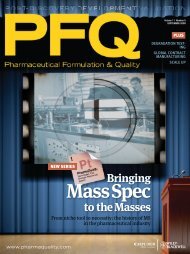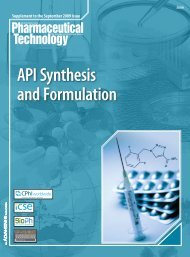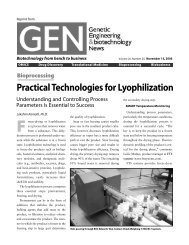High-Temperature Stability | Do the Math for Shelf Life - Sterile ...
High-Temperature Stability | Do the Math for Shelf Life - Sterile ...
High-Temperature Stability | Do the Math for Shelf Life - Sterile ...
- No tags were found...
You also want an ePaper? Increase the reach of your titles
YUMPU automatically turns print PDFs into web optimized ePapers that Google loves.
QUALITY CONTROL | HIGH-TEMPERATURE STABILITYby three months (k40 = 0.3333% w/wdegradant/ month), levels at 25 degrees Cwill reach 1% w/w be<strong>for</strong>e 12 months, and ashelf life of 12 months is not kineticallysupported. The in<strong>for</strong>mation in Table 5 canbe used to estimate shelf life based upon<strong>the</strong> Ea and stability at 40 degrees C.The practice of predicting long-termchemical stability at a lower temperatureusing data generated at a higher temperatureover a shorter time period is basedupon application of <strong>the</strong> Arrhenius kineticmodel. The Arrhenius equation can beapplied regardless of <strong>the</strong> order of <strong>the</strong> reactionkinetics. By using <strong>the</strong> Ea with <strong>the</strong>experimental level of drug or degradantobtained at a higher temperature (40degrees C), <strong>the</strong> expected level of drug ordegradant over long-term storage at alower temperature (25 degrees C) can bemore accurately predicted and <strong>the</strong> kineticshelf life estimated. The proportionalityof six months storage at 40degrees C as predictive of 12 months at25 degrees C is predicated upon an activationenergy of 9 kcal/mole. The proportionalityof six months storage at 40degrees C as predictive of 24 months at25 degrees C is predicated upon an activationenergy of 17 kcal/mole. As <strong>the</strong>activation energy increases, <strong>the</strong> temperaturesensitivity of <strong>the</strong> reaction increases,resulting in a greaterdifference in <strong>the</strong> rates at different temperatures.The in<strong>for</strong>mation in Table 5can also be used to estimate shelf life at25 degrees C based upon <strong>the</strong> activationenergy and <strong>the</strong> stability at 40 degreesC. As presented, <strong>the</strong> Arrhenius kineticmodel can be applied to specific drugchemistry to scientifically justify appropriatemonths at accelerated 40 degreesC condition <strong>for</strong> submission. nREFERENCES1. Martin A. Physical Pharmacy: PhysicalChemical Principles in <strong>the</strong> PharmaceuticalSciences. 4 th ed. Philadelphia: Lea &Febiger; 1993: Chapter 12, Kinetics, pages284-323.2. Lachman L, Lieberman HA, Kanig JL. TheTheory and Practice of Industrial Pharmacy.3 rd ed. Philadelphia: Lea & Febiger;1986:765-767.3. Wigent RJ. Chemical kinetics. In: GennaroAR, ed. Remington: The Science and Practiceof Pharmacy. 20 th ed. Philadelphia:Lippincott Williams & Wilkins; 2000.4. Carstensen JT. Drug <strong>Stability</strong>: Principles andPractices. New York: Marcel Dekker;1990:29-34.5. Conners KA, Amidon GL, Stella VJ. Chemical<strong>Stability</strong> of Pharmaceuticals: A Handbook <strong>for</strong>Pharmacists. 2 nd ed. New York: John Wiley &Sons; 1986:24.6. Brönsted JN, Guggenheim EA. Contributionto <strong>the</strong> <strong>the</strong>ory of acid and base catalysis: <strong>the</strong>mutarotation of glucose. J Am Chem Soc.1927;49(10):2554-2584.7. Taylor RB, Jappy BM, Neil JM. Kinetics ofdextrose degradation under autoclaving conditions.J Pharm Pharmacol. 1972;24(2):121-129.8. Sturgeon RJ, Athanikar NK, Hartison HA, etal. Degradation of dextrose during heatingunder simulated sterilization. J Parenter DrugAssoc. 1980;34(3):175-182.9. U.S. Pharmacopeia–National Formulary. Dextroseinjection monograph. Available at:www.uspnf.com.10. Hryncewicz CL, Koberda M, Konkowski MS.Quantitation of 5-hydroxymethylfurfural (5-HMF) and related substances in dextroseinjections containing drugs and bisulfite. JPharm Biomed Anal. 1996;14(4):429-434.11. Heimlich KR, Martin AN. A kinetic study ofglucose degradation in acid solution. J AmPharm Assoc. 1960;49(9):592-597.12. U.S. Food and Drug Administration. Center<strong>for</strong> Drug Evaluation and Research. Center <strong>for</strong>Biologics Evaluation and Research. Guidance<strong>for</strong> Industry: Q1A(R2) <strong>Stability</strong> Testing of NewDrug Substances and Products. Washington,D.C.: U.S. Food and Drug Administration;2003.Michelle Duncan is an associate director in global research and development withBaxter Healthcare. She holds a bachelor’s in biochemistry and molecular biology fromNorthwestern University and earned her PhD in pharmaceutics from <strong>the</strong> University ofTexas at Austin. She specializes in <strong>the</strong> <strong>for</strong>mulation development of parenteral products and hasled numerous injectables through FDA approval (NDA and ANDA routes) and to successful commercialization.Irene Zaretsky is a research associate with Baxter, supporting analytical and<strong>for</strong>mulation development. She earned her master’s in chemistry from <strong>the</strong> Institute of Technologyin Minsk, Belarus, and has worked more than 13 years in <strong>the</strong> U.S. pharmaceutical industry.BaxterBioPharmaSolutions.comContact us at biopharmasolutions@baxter.comReprinted with permission from PFQ Magazine April/May 2011.






